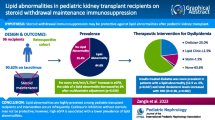Abstract
Background
The arrival of tacrolimus has drastically improved AALDLT recipients’ survival. However, little data of tacrolimus have been reported concerning its effects on lipid metabolism for AALDLT recipients.
Aim
Out aim was to investigate the relationship between tacrolimus blood concentration and lipid metabolism in AALDLT recipients.
Methods
The pre and postoperative data of 77 adult patients receiving AALDLT between 2002 and December 2007 were retrospectively reviewed. The postoperative immune suppressive regimen was prednisone with tacrolimus ± mycophenolate mofetil. Prednisone was withdrawn within the first postoperative month. Blood lipids and tacrolimus concentration were detected at the first, third, and sixth month during follow-up. Episodes of acute rejection were diagnosed based on biopsy.
Results
Overall prevalence of post-transplantation hyperlipidemia was 29.9% (23/77) at the sixth postoperative month. The patients were divided into two groups, the hyperlipidemia group and the ortholipidemia group. In the 23 patients with hyperlipidemia, 15 (65%) were hypercholesterolemia, five (22%) were hypertriglyceridemia, and three (13%) patients had both hypercholesterolemia and hypertriglyceridemia. In univariate analysis, only tacrolimus blood concentration at the third and sixth post-transplantation months showed significant difference (8.7 ± 2.1 vs. 6.9 ± 3.2, p = 0.013; 9.2 ± 2.7 vs. 7.3 ± 3.8, p = 0.038, respectively). In multivariate logistic analysis, only two factors appear to be risk factors, namely, tacrolimus blood concentration at the third and sixth post-transplantation months (8.7 ± 2.1 vs. 6.9 ± 3.2, p = 0.043; 9.2 ± 2.7 vs. 7.3 ± 3.8 p = 0.035, respectively).
Conclusions
Higher tacrolimus blood concentration was related to hyperlipidemia at an early postoperative period. This indicates that tacrolimus blood concentration should be controlled as low as possible in the premise that there is no risk of rejection to minimize post-transplant hyperlipidemia after AALDLT.

Similar content being viewed by others
Abbreviations
- AALDLT:
-
Adult-to-adult living donor liver transplantation
- BMI:
-
Body mass index
- CsA:
-
Ciclosporin A
- CI:
-
Confidence interval
- DM:
-
Diabetes mellitus
- HBV:
-
Hepatitis B virus
- LPL:
-
Lipoprotein lipase
- MELD:
-
Model for end-stage liver disease
- MMF:
-
Mycophenolate mofetil
- Mo:
-
Month
- NS:
-
Not significant
- OR:
-
Odds ratio
- SD:
-
Standard deviation
- TB:
-
Total bilirubin
- TG:
-
Triglycerides
- LDL:
-
Low-density lipoprotein
- HDL:
-
High-density lipoprotein
References
Manzarbeitia C, Reich DJ, Rothstein KD, Braitman LE, Levin S, Munoz SJ. Tacrolimus conversion improves hyperlipidemic states in stable liver transplant recipients. Liver Transpl. 2001;7:93–99.
Canzanello VJ, Schwartz L, Taler SJ, et al. Evolution of cardiovascular risk after liver transplantation: a comparison of cyclosporine A and tacrolimus (FK506). Liver Transpl Surg. 1997;3:1–9.
Smith SL. Risk factors for premature coronary heart disease after successful liver transplantation in adults. J Transpl Coord. 1996;6:178–185.
Stegall MD, Everson G, Schroter G, Bilir B, Karrer F, Kam I. Metabolic complications after liver transplantation. Diabetes, hypercholesterolemia, hypertension, and obesity. Transplantation. 1995;60(9):1057–1060.
Tisone G, Angelico M, Palmieri G, et al. A pilot study on the safety and effectiveness of immunosuppression without prednisone after liver transplantation. Transplantation. 1999;67:1308–1313.
Charco R, Cantarell C, Vargas V, et al. Serum cholesterol changes in long-term survivors of liver transplantation: a comparison between cyclosporine and tacrolimus therapy. Liver Transpl Surg. 1999;5:204–208.
Koletzko B, Herzog M. Hyperlipidemia in children and adolescents: diagnosis and therapy. Schweiz Med Wochenschr. 1998;128:477–485.
Kamath PS, Wiesner RH, Malinchoc M, et al. A model to predict survival in patients with end-stage liver disease. Hepatology. 2001;33:464–470.
Fernandez LA, Lehmann R, Luzi L, et al. The effects of maintenance doses of FK506 versus cyclosporin A on glucose and lipid metabolism after orthotopic liver transplantation. Transplantation. 1999;68:1532–1541.
Neuhaus P, Langrehr JM, Williams R, Calne RY, Pichlmayr R, McMaster P. Tacrolimus-based immunosuppression after liver transplantation: a randomised study comparing dual versus triple low-dose oral regimens. Transpl Int. 1997;10:253–261.
Jindal RM, Popescu I, Emre S, et al. Serum lipid changes in liver transplant recipients in a prospective trial of cyclosporine versus FK506. Transplantation. 1994;57:1395–1398.
Hohage H, Arlt M, Bruckner D, Dietl KH, Zidek W, Spieker C. Effects of cyclosporin A and FK 506 on lipid metabolism and fibrinogen in kidney transplant recipients. Clin Transplant. 1997;11:225–230.
Dehghani SM, Taghavi SA, Eshraghian A, et al. Hyperlipidemia in Iranian liver transplant recipients: prevalence and risk factors. J Gastroenterol. 2007;42:769–774.
Tory R, Sachs-Barrable K, Goshko CB, Hill JS, Wasan KM. Tacrolimus-induced elevation in plasma triglyceride concentrations after administration to renal transplant patients is partially due to a decrease in lipoprotein lipase activity and plasma concentrations. Transplantation. 2009;88:62–68.
Padbury RT, Gunson BK, Dousset B, et al. Steroid withdrawal from long-term immunosuppression in liver allograft recipients. Transplantation. 1993;55:789–794.
Conflict of interest
Hongyu Li and the other co-authors have no conflicts of interest.
Author information
Authors and Affiliations
Corresponding author
Rights and permissions
About this article
Cite this article
Li, HY., Li, B., Wei, YG. et al. Higher Tacrolimus Blood Concentration Is Related to Hyperlipidemia in Living Donor Liver Transplantation Recipients. Dig Dis Sci 57, 204–209 (2012). https://doi.org/10.1007/s10620-011-1817-5
Received:
Accepted:
Published:
Issue Date:
DOI: https://doi.org/10.1007/s10620-011-1817-5




